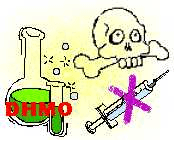What Are Some of the Dangers Associated with DHMO?
April 1, 2002
Each year, Dihydrogen Monoxide is a known causative component in many thousands of deaths and is a major contributor to millions upon millions of dollars in damage to property and the environment. Some of the known perils of Dihydrogen Monoxide are:
- Death due to accidental inhalation of DHMO, even in small quantities.
- Prolonged exposure to solid DHMO causes severe tissue damage.
 Excessive
ingestion produces a number of unpleasant though not typically life-threatening
side-effects.
Excessive
ingestion produces a number of unpleasant though not typically life-threatening
side-effects. - DHMO is a major component of acid rain.
- Gaseous DHMO can cause severe burns.
- Contributes to soil erosion.
- Leads to corrosion and oxidation of many metals.
- Contamination of electrical systems often causes short-circuits.
- Exposure decreases effectiveness of automobile brakes.
- Found in biopsies of pre-cancerous tumors and lesions.
- Often associated with killer cyclones in the U.S. Midwest and elsewhere.
- Thermal variations in DHMO are a suspected contributor to the El Nino weather effect.
What are some uses of Dihydrogen Monoxide?
Despite the known dangers of DHMO, it continues to be used daily by industry, government, and even in private homes across the U.S. and worldwide. Some of the well-known uses of Dihydrogen Monoxide are:
- as an industrial solvent
and coolant,

- in nuclear power plants,
- by the U.S. Navy in the propulsion systems of some older vessels,
- by elite athletes to improve performance,
- in the production of Styrofoam,
- in biological and chemical weapons manufacture,
- as a spray-on fire suppressant and retardant,
- as a major ingredient in many home-brewed bombs,
- as a byproduct of hydrocarbon combustion in furnaces and air conditioning compressor operation,
- in cult rituals,
- by both the KKK and the NAACP during rallies and marches,
- by the Serbian military as authorized by Slobodan Milosevic in their recent ethnic cleansing campaign,
- in animal research laboratories, and
- in pesticide production and distribution
The chemical formula for this dangerous material is H2O. Please note the date that this was first published. This article was borrowed from http://www.mercola.com. For more information on this April fool's prank, see http://www.dhmo.org/.